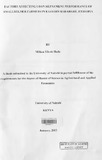| dc.description.abstract | The use of credit has been envisaged as one way of promoting technology transfer, while the use of reo om mended farm inputs is regarded as key to agricultural development. Credit repayment is also of paramount - importance to have viable financial institutions. In Eastern Hararghe, Oromiya Zone, the Regional Government and Non-Governmental organizations are extending credit facilities to fanning households in order to narrow the gap between the capital required and the capital that the households possess, for the improvement of agricultural technologies that would increase production and productivity. However, there is a serious loan repayment problem in the area, which discourages rural finance organizations from promoting and extending credit.
.
Loan defaults are estimated at 23.85 percent OSCSC (2009). Therefore, the objective of this
study was to identify the factors affecting the loan repayment performance of farmers in Eastern Hararghe zone.
Primary data was collected through structured questionnaires, from 140 randomly selected farm household users of credit in two agro ecological zones of Eastern Hararghe . Secondary data was obtained from publications, seasonal and annual reports of the district, zonal and regional offices of the Ministry of Agriculture and Rural Development, Development Bank of Ethiopia, Micro Finance Office and other related organizations. Descriptive statistics were used to describe the socio-economic characteristics of the respondents, and the two-limit Tobit model was used to analyze the factors influencing loan repayment of smallholder farmers in the study area.
The results of the descriptive analysis revealed a significant mean difference between the defaulter and non-defaulter households in terms of education, experience of credit use, distance from credit source, technical assistance, livestock units, total annual income and total land. Moreover, off farm income, crop and livestock disease, social ceremonies and education level were systematically associated with loan repayment. However, other variable such as age, family size, amount of loan, were not significantly different between the defaulters and the n011- defaulters.
The two limit Tobit model results indicated that seven out of the 16 explanatory variables considered influenced loan repayment performance in the area. Agro ecological zone, off-farm activity, and frequency of contact with extension agents positively and significantly influenced
x
loan repayment while, production loss, informal credit, social ceremonies, and loan-income ratio negatively influenced the loan repayment performance of small holder farmers in the study area.
The study recommends increasing the number of development agents to change the farmers' attitude toward agricultural transformation and timely settlement of debt. Rural development strategies should not only emphasize on increasing agricultural production but simultaneous attention should be paid to promoting off-farm activities in the rural areas. The social ceremonies which are commonly celebrated, require a great deal of investment ,beyond what the farmers can afford, and were found to be one of the major causes of delinquency in the payment of formal loans. -Thus, there should be some sensitization for the elders, community leaders, local associations and religious organizations to realize the need to minimize these traditional ceremonies and mitigate the associated expenditure through time. The agro-ecology zone is one of the factors that affect the type and range of crops to be grown and animals to be kept. Therefore, policies and strategies geared towards the development and promotion of new technologies, suitable to moisture deficit areas, should be given adequate emphasis in order to improve the loan repayment capacity of smallholder farmers living in such drier areas of the zone. In addition membership of specific groups should be optional, to allow individual members to screen each other effectively, a phenomenon of group advantage for information symmetry that is not available in the emerging microfinance set ups which fix members to groups. | en |

